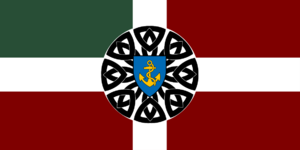Burgundine-Fhainnin Naval Academy
The Burgindine-Fhainnin Joint Cooperative Naval Officers' Academy (BFJCNOA or JNA) is a naval officers' academy, crew training school, and naval architects' school based in Faneria, with its primary campus in Rihsport, Gleathan Province. The Academy is one of the two major naval colleges in Faneria and accepts international students from friendly nations.
 Standard of the BFNA | |
| Company type | Government-Owned |
|---|---|
| Industry | Naval Design, Naval Training, Maritime Research, Education |
| Founded | 1604 |
| Founder | Rih Donan Suthar-Màrtainn |
| Headquarters | , |
Number of locations | 4 |
Early History
The BFNA was founded as the Royal Foreign Naval Training Association in August 8, 1604 under the direction of Rih Donan Suthar-Màrtainn, who was becoming frustrated only a year into his rule by Vithinjan piracy along Faneria's outer coast. He initiated a program of hiring foreign naval officers to supplement Fhainninn troops, as they were not yet used to operating on the open oceans outside of the Vandarch, and required ship designs and leadership from abroad to seriously compete with raiders in the Nordska sea. The Academy was initially centered on Rihsport, and attracted Coscivian and Burgundine officers, although Burgundine mercenaries eventually became more commonplace due to their contemporary colonial expansion. Many successful officers came to see the Association as an easy posting with good pay, barring several undeclared conflicts with Vithinjan clans raiding into Bah Lannan and along the Vraellan coastline.
The Association was rebranded as the Burgundine-Fhainnin Joint Naval Officers' College in 1738, absorbing the institution of the Royal Naval Academy and becoming the primary naval officers' academy for the Fhainnin navy.
Revolution
The Academy roused its students to create a Navy Trainee Brigade during the summer of 1906 during the Fhainnin Civil War, siding with the Royalists and promptly being routed and captured following the fall of Rihsport to Republican forces. After the Civil War ended in 1909, the College was rebranded as the modern BFJCNOA, or simply the Joint Naval Officers' Academy. Most of the educators and planners there were screened and phased out for new talent less loyal to the Throne, which would slow Faneria's preparations leading up to the Second Great War as their talented pool of doctrinal analysts would not recover until the mid-1930s. In 1912, the National Naval Officers' College was founded, serving as the Academy's primary competing government organization to the present day.
Great War Era
During the prewar years of 1909-1927, Fhainnin naval direction was focused heavily on the concept of prioritizing speed and firepower over protection, emphasizing the use of fast battleships and fast cruisers for line combat supplemented by a suite of auxiliary air support, mine warfare, and anti-air destroyers and light carriers. Due to the defections and purges of the Navy after it largely sided with Royalist forces in the civil war, the Army Naval Bureau struggled to accomplish this task, and prioritized fast battlecruisers and mine warfare first in the event of a war. Trainees were also influenced heavily by the radical push towards hit-and-fade fighting promulgated by the new leadership, but this break from the traditional protected battleship doctrine of the Royal Navy took over a decade to properly inculcate in the standing naval forces of the Republic and lead to a series of both dramatic victories and stunning blunders as the Navy's officer corps was forced to shake out and fine-tune its new doctrine quickly in wartime.
The BFNA was stuck in an awkward position, being on the opposite side of Burgundie, leading to a predominance of Fhainnin and Coscivian students during the war years and for several decades afterwards.
Postwar and Modern Era
Post-war Faneria struggled through two decades of political and social upheaval, and it appeared as though the Academy would be disbanded entirely and absorbed by the NNOC due to its loss of prestige in the early 20th Century. This fortune was dramatically reversed in 1985, when the governments of Faneria and Burgundie signed a formal treaty as part of Faneria's program of national reconciliation. The treaty revitalized the Academy, inviting foreign students and teachers from Burgundie and commissioning Burgoignesc citizens to serve in the Army Naval Bureau in a number of support and on-board officers' roles.
In 2025, the Navy of Burgundie gifted a National Security Multi-Mission Training Vessel, celebrating the 40th anniversary of the signing of the treaty.